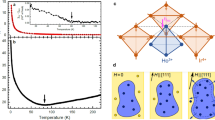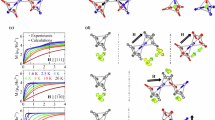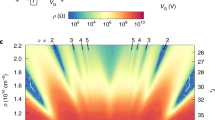Abstract
A non-Ohmic current that grows exponentially with the square root of applied electric field is well known from thermionic field emission (the Schottky effect)1, electrolytes (the second Wien effect)2 and semiconductors (the Poole–Frenkel effect)3. It is a universal signature of the attractive Coulomb force between positive and negative electrical charges, which is revealed as the charges are driven in opposite directions by the force of an applied electric field. Here we apply thermal quenches4 to spin ice5,6,7,8,9,10,11 to prepare metastable populations of bound pairs of positive and negative emergent magnetic monopoles12,13,14,15,16 at millikelvin temperatures. We find that the application of a magnetic field results in a universal exponential-root field growth of magnetic current, thus confirming the microscopic Coulomb force between the magnetic monopole quasiparticles and establishing a magnetic analogue of the Poole–Frenkel effect. At temperatures above 300 mK, gradual restoration of kinetic monopole equilibria causes the non-Ohmic current to smoothly evolve into the high-field Wien effect2 for magnetic monopoles, as confirmed by comparison to a recent and rigorous theory of the Wien effect in spin ice17,18. Our results extend the universality of the exponential-root field form into magnetism and illustrate the power of emergent particle kinetics to describe far-from-equilibrium response in complex systems.
This is a preview of subscription content, access via your institution
Access options
Subscribe to this journal
Receive 12 print issues and online access
$259.00 per year
only $21.58 per issue
Buy this article
- Purchase on SpringerLink
- Instant access to full article PDF
Prices may be subject to local taxes which are calculated during checkout




Similar content being viewed by others
References
Schottky, W. Über den Einfluß von Strukturwirkungen, besonders der Thomsonschen Bildkraft, auf die Elektronenemission der Metalle. Z. Phys. 15, 872–878 (1914).
Onsager, L. Deviations from Ohm’s law in weak electrolytes. J. Chem. Phys. 2, 599–615 (1934).
Frenkel, J. On pre-breakdown phenomena in insulators and electronic semi-conductors. Phys. Rev. 4, 647–648 (1938).
Paulsen, C. et al. Far-from-equilibrium monopole dynamics in spin ice. Nature Phys. 10, 135–139 (2014).
Harris, M. J., Bramwell, S. T., McMorrow, D. F., Zeiske, T. & Godfrey, K. W. Geometrical frustration in the ferromagnetic pyrochlore Ho2Ti2O7 . Phys. Rev. Lett. 79, 2554–2557 (1997).
Bramwell, S. T. & Harris, M. J. Frustration in Ising-type spin models on the pyrochlore lattice. J. Phys. Condens. Matter 10, L215–L220 (1998).
Ramirez, A. P., Hayashi, A., Cava, R. J., Siddharthan, R. B. & Shastry, S. Zero-point entropy in spin ice. Nature 399, 333–335 (1999).
Siddharthan, R. et al. Ising pyrochlore magnets: low-temperature properties, ice rules, and beyond. Phys. Rev. Lett. 83, 1854–1857 (1999).
den Hertog, B. C. & Gingras, M. J. P. Dipolar interactions and origin of spin ice in Ising pyrochlore magnets. Phys. Rev. Lett. 84, 3430–3433 (2000).
Melko, R. G., den Hertog, B. C. & Gingras, M. J. P. Long-range order at low temperatures in dipolar spin ice. Phys. Rev. Lett. 87, 067203 (2001).
Bramwell, S. T. & Gingras, M. J. P. Spin ice state in frustrated magnetic pyrochlore materials. Science 294, 1495–1501 (2001).
Castelnovo, C., Moessner, R. & Sondhi, S. L. Magnetic monopoles in spin ice. Nature 451, 42–45 (2008).
Ryzhkin, I. A. Magnetic relaxation in rare-earth pyrochlores. J. Exp. Theor. Phys. 101, 481–486 (2005).
Jaubert, L. D. C. & Holdsworth, P. C. W. Signature of magnetic monopole and Dirac string dynamics in spin ice. Nature Phys. 5, 258–261 (2009).
Jaubert, L. D. C. & Holdsworth, P. C. W. Magnetic monopole dynamics in spin ice. J. Phys. Condens. Matter 23, 164222 (2011).
Castelnovo, C., Moessner, R. & Sondhi, S. L. Thermal quenches in spin sce. Phys. Rev. Lett. 104, 107201 (2010).
Kaiser, V., Bramwell, S. T., Holdsworth, P. C. W. & Moessner, R. Onsager’s Wien effect on a lattice. Nature Mater. 12, 1033–1037 (2013).
Kaiser, V., Bramwell, S. T., Holdsworth, P. C. W. & Moessner, R. AC Wien effect in spin ice, manifest in non-linear non-equilibrium susceptibility. Phys. Rev. Lett. 115, 037201 (2015).
Bramwell, S. T. et al. Measurement of the charge and current of magnetic monopoles in spin ice. Nature 461, 956–959 (2009).
Giblin, S. R., Bramwell, S. T., Holdsworth, P. C. W., Prabhakaran, D. & Terry, I. Creation and measurement of long-lived magnetic monopole currents in spin ice. Nature Phys. 7, 252–258 (2011).
Snyder, J. et al. Low-temperature spin freezing in the Dy2Ti2O7 spin ice. Phys. Rev. B 69, 064414 (2004).
Pomaranski, D. et al. Absence of Pauling’s residual entropy in thermally equilibrated Dy2Ti2O7 . Nature Phys. 9, 353–356 (2013).
McClarty, P. et al. Chain-based order and quantum spin liquids in dipolar spin ice. Phys. Rev. B 92, 094418 (2015).
Bramwell, S. T. Generalised longitudinal susceptibility for magnetic monopoles in spin ice. Phil. Trans. R. Soc. A 370, 5738–5766 (2012).
Bovo, L., Jaubert, L. D. C., Holdsworth, P. C. W. & Bramwell, S. T. Crystal shape-dependent magnetic susceptibility and Curie law crossover in the spin ices Dy2Ti2O7 and Ho2Ti2O7 . J. Phys. Condens. Matter 25, 386002 (2013).
Matsuhira, K. et al. Spin dynamics at very low temperature in spin ice Dy2Ti2O7 . J. Phys. Soc. Jpn 80, 123711 (2011).
Yaraskavitch, L. R. et al. Spin dynamics in the frozen state of the dipolar spin ice material Dy2Ti2O7 . Phys. Rev. B 85, 020410(R) (2012).
Revell, H. M. et al. Evidence of impurity and boundary effects on magnetic monopole dynamics in spin ice. Nature Phys. 9, 34–37 (2013).
Sala, G. et al. Vacancy defects and monopole dynamics in oxygen-deficient pyrochlores. Nature Mater. 13, 488–493 (2014).
Dunsiger, S. R. et al. Spin ice: magnetic excitations without monopole signatures using muon spin rotation. Phys. Rev. Lett. 107, 207207 (2011).
Blundell, S. J. Monopoles, magnetricity, and the stray field from spin ice. Phys. Rev. Lett. 108, 147601 (2012).
Chang, L. J., Lees, M. R., Balakrishnan, G., Kao, Y.-J. & Hillier, A. D. Low-temperature muon spin rotation studies of the monopole charges and currents in Y doped Ho2Ti2O7 . Sci. Rep. 3, 1881 (2013).
Nuccio, L., Schulz, L. & Drew, A. J. Muon spin spectroscopy: magnetism, soft matter and the bridge between the two. J. Phys. D 47, 473001 (2014).
Sinha, K. P. & Kumar, N. Interactions in Magnetically Ordered Solids (Oxford Univ. Press, 1980).
Tholence, J. L. & Salamon, M. B. Field and temperature dependence of the magnetic relaxation in a dilute CuMn spin glass. J. Magn. Magn. Mater. 31–34, 1340–1342 (1983).
Lundgren, L., Svedlindh, P. & Beckman, O. Experimental indications for a critical relaxation time in spin-glasses. Phys. Rev. B 26, 3990–3993 (1982).
Acknowledgements
C.P. acknowledges discussions and mathematical modelling help from C. Gignoux. S.T.B. thanks his collaborators on refs 17,18—V. Kaiser, R. Moessner and P. Holdsworth—for many useful discussions concerning the theory of the Wien effect in spin ice. S.R.G., D.P. and G.B. thank EPSRC for funding. We thank M. Ruminy for assistance with sample preparation. The crystal growth by K.M. was carried out under the Visiting Researchers Program of the Institute for Solid State Physics, the University of Tokyo.
Author information
Authors and Affiliations
Contributions
Experiments were conceived, designed and performed by C.P., E.L. and S.R.G. The data were analysed by C.P., E.L., S.R.G. and S.T.B., who adapted the theory of ref. 18. Contributed materials and analysis tools were made by K.M., D.P. and G.B. The paper was written by S.T.B., C.P., E.L. and S.R.G.
Corresponding author
Ethics declarations
Competing interests
The authors declare no competing financial interests.
Supplementary information
Supplementary information
Supplementary information (PDF 4928 kb)
Rights and permissions
About this article
Cite this article
Paulsen, C., Giblin, S., Lhotel, E. et al. Experimental signature of the attractive Coulomb force between positive and negative magnetic monopoles in spin ice. Nature Phys 12, 661–666 (2016). https://doi.org/10.1038/nphys3704
Received:
Accepted:
Published:
Issue date:
DOI: https://doi.org/10.1038/nphys3704
This article is cited by
-
Magnetic monopole noise
Nature (2019)
-
Nuclear spin assisted quantum tunnelling of magnetic monopoles in spin ice
Nature Communications (2019)
-
Phase transitions in few-monolayer spin ice films
Nature Communications (2019)
-
Two fluid model in low energy excited states within spin-ice systems
Scientific Reports (2018)
-
Harmonic phase in polar liquids and spin ice
Nature Communications (2017)



